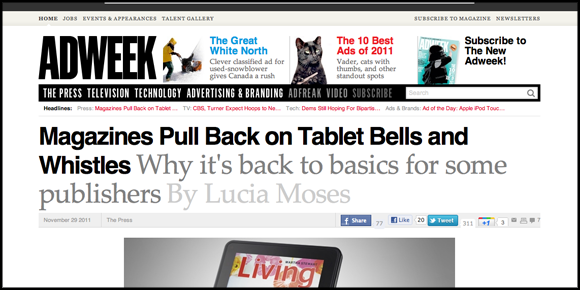Tablets
11.30.11
Does One Size Fit All? Let's Discuss!
 Adweek yesterday stirred the blogosphere with an article titled "Magazines Pull Back on Tablet Bells and Whistles; Why It's Back To Basics for Some Publishers," quoting publishing executives about how they are simplifying their tablet editions in order to reach as many types of devices as possible. "Interactive elements are valuable to [readers], but they're a secondary benefit," said Time Inc.'s Steve Sachs. Chris Wilkes of Hearst Magazines' App Lab warned that interactive elements are "more likely to be distracting, cause confusion and occasionally irritate customers."
Adweek yesterday stirred the blogosphere with an article titled "Magazines Pull Back on Tablet Bells and Whistles; Why It's Back To Basics for Some Publishers," quoting publishing executives about how they are simplifying their tablet editions in order to reach as many types of devices as possible. "Interactive elements are valuable to [readers], but they're a secondary benefit," said Time Inc.'s Steve Sachs. Chris Wilkes of Hearst Magazines' App Lab warned that interactive elements are "more likely to be distracting, cause confusion and occasionally irritate customers."The design community was quick to respond.
Joe Zeff of Joe Zeff Design blogged "Bah humbug!" in his "More Bells and Whistles, Please!" post. "The tablet is where tomorrow's readers establish relationships with today's magazine brands. A passive stack of PDFs won't satisfy them, regardless of how many devices the publisher targets." Mario Garcia agreed in his well-read The Mario Blog. "I refuse to use the phrase 'bells and whistles.' The tablet is a multi-genre platform: one reads, one sees, one hears, one watches videos. It is the combination of these genres that make for a satisfied user."
Zeff makes the case that one size does not fit all, citing unique opportunities that go unattended by simply replicating a printed magazine in multiple form factors on multiple devices.
"There are two primary form factors -- 7-inch devices with 16:9 screens and 10-inch devices with 4:3 screens -- and significant differences between devices in each category," said Zeff, whose studio worked on bestselling author Timothy Ferriss' first app for the Kindle Fire, "A Christmas Countdown Experiment: The 4-Hour Chef Teaser (Kindle Fire Edition)" now available from Amazon.
"The 7-inch devices are well suited as readers, presenting words and pictures with interactivity that complements the experience. The Kindle Fire in particular adds the benefit of linkage to Amazon's one-click shopping capability, turning magazines into e-commerce portals. At the same time, its lack of 3G makes it a different play than the Samsung Galaxy Tab that can connect to the Internet anywhere, anytime.
"The 10-inch devices beg for interaction -- their large screens come to life when swiped and poked. But here's where the iPad crushes its Android competition: the ubiquity of easy-to-use Apple products and the integration between them. The biggest challenge in selling apps is letting people know about them, and Apple makes apps easier to sell than other marketplaces, with a well laid-out iTunes Store accessible from multiple devices."
Two issues here: bells and whistles, and whether some devices require different approaches than others. Let's discuss!
